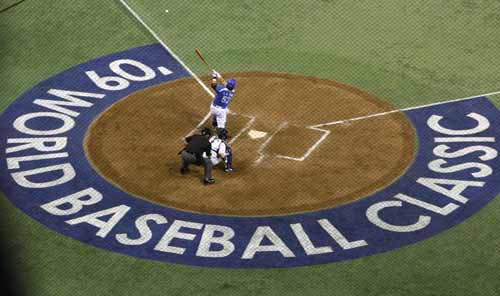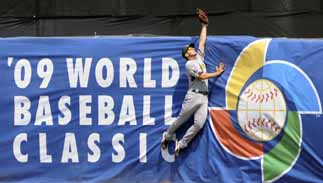What is the World Baseball Classic?

Korea’s Kim Tae-kyun hits a single in the fourth inning of the World Baseball Classic Asian round against Japan at the Tokyo Dome on March 9.
It's only March and the baseball season is still a few weeks away. So why are we seeing professional ball players, dressed in their national team uniforms, going all out on national television these days?
For casual or non-sports fans, we're here to help. These baseball all-stars are playing in a tournament called the World Baseball Classic. It's often referred to as its acronym, WBC, though boxing fans and World Boxing Council officials might not be too pleased about that.
The first WBC was held in the spring of 2006. Major League Baseball created the tournament in collaboration with the Major League Baseball Players Association and other professional leagues around the world, including the Korea Baseball Organization.

South Africa’s Martin Gordon jumps as he tracks a fly ball home run by Cuba’s Yoennis Cespedes during the sixth inning of their World Baseball Classic game in Mexico City on March 8.[REUTERS]
For the record, the WBC is not technically a world cup, as there is another competition called the Baseball World Cup. There have been 36 Baseball World Cups, but it’s really a world cup in name only. Until 1996, the event was confined to amateur players. Even now, only U.S. minor leaguers compete in the tournament.
But back to the topic at hand. From the get-go, the WBC was destined to be a profit-making machine, the idea being that pitting the best players from the world’s best leagues against one another would perk up fan interest and increase revenue.
Perhaps the stadium wouldn't be a full house for a match between, say, the United States and baseball minnows South Africa ? their lopsided 17-0 match in 2006 drew under 12,000 ? but tournament organizers had secured a host of high-profile major international corporate sponsors. And the 2006 tournament games drew diverse audiences from all over the world.
According to the 2006 World Baseball Classic Steering Committee’s interim report, the tournament had 50 sponsors and 21 companies licensed to provide official team apparel. Games were broadcast in 205 countries in seven different languages, the report noted, and 48 different media outlets covered the event. In all, the report claimed the inaugural WBC would bring in profits of about $12 million.
The WBC seems to be the best thing that could have happened to professional baseball. Its beginnings, however, were not as smooth.
The MLB announced plans for the WBC in May of 2005, after having worked to create the event for at least two years. The league’s franchise owners, however, were concerned about the possibility of having players injured before the season began, since the WBC was scheduled for March. There was also the question of how to provide insurance for contracted players who could get injured at the WBC, which meant they could lose valuable playing time during the professional season. A deal was eventually reached to provide contracted players with insurance. Also, the tournament organizers imposed pitch count limits to protect pitchers from heavy workloads.
Let’s talk about the timing of the tournament. We said at the top that we’re still a few weeks away from the start of the professional season. This is usually the time of the year when pro ball players are getting ready, physically and mentally, for the new season and are playing relatively stress-free spring training games.
Take the MLB, for instance. Players report to their respective teams’ spring training camps in mid-February. Pitchers and catchers report about a week earlier than position players because they tend to take longer to warm up and they also stand to benefit from more extensive training before the season gets underway.
In other words, pro ball players’ body clocks are set to start running in earnest in mid- to late March ? that is, just a couple of weeks before the real season starts. So we probably shouldn’t expect all the MLB stars to be in fighting shape, at least for the first WBC game. At a time when they’re more accustomed to taking it easy in the sun ? MLB spring training takes place in the sunny states of Florida and Arizona ? players are suddenly asked to perform in real games, playing for national pride with millions of people watching.
That’s why the WBC so far ? the second round is just getting underway ? has seen a slew of surprising victories by nations with just a few major leaguers.
In 2006, Korea defeated the United States 7-3 in the second round. The American team was made up entirely of MLB All-Stars, while
Korea’s major leaguers, pitchers Park Chan-ho, Kim Byung-hyun and Seo Jae-weong, weren’t exactly in their prime.
Korea went all the way to the semifinals, defeating regional rival Japan twice in the process. But in the semis, by the quirks of the schedule, Korea met Japan for the third time in the tournament and fell 6-0.
Korea and Japan finished 1-2 in the Asian regional qualifier. In the second round, they were paired in the same group as the United
States and Mexico, and Korea and Japan once again finished first and second.
In the other second-round group, the Dominican Republic and Cuba were the top two teams. But instead of facing a team from that group, Korea ended up playing Japan again in the semis. Despite winning the championship by beating Cuba in the final, Japan lost three times in eight matches overall, twice to Korea. The Korean team played seven games and lost only once, to Japan in the fateful semifinal.
In the FIFA World Cup, teams only play each other twice at most, once in the round-robin group stage and again for the championship or third place.
The scheduling for this year’s WBC is even more complicated and no less controversial, and a “double elimination” format has been adopted. The 16 nations were divided into groups of four, while the second round features two groups of four. In each round, the first two teams to lose two games are eliminated.
To better explain double elimination, let's recap this year’s Asian qualification round. Japan beat China and Korea defeated Taiwan to open their WBC play. Japan and Korea moved into the winner’s bracket, while China and Taiwan competed in the loser’s bracket.
China beat Taiwan to advance to the consolation bracket and, since Taiwan already had two losses, it was knocked out of the tournament.
Meanwhile in the winner’s bracket, Japan defeated Korea and clinched a spot in the next round. Then Korea and China faced each other in the elimination game. Since each had a loss apiece, the next loss would mean a flight home. Korea easily defeated China.
But it wasn’t over. Korea and Japan were the last two standing, but we had to determine who would finish first in Asia. Korea avenged the earlier loss and ended at the top of the Asian phase.
Korea and Japan have once again been paired in the same bracket in round two, and are joined by Cuba and Mexico. The two Asian rivals could theoretically meet each other twice more in the second round ? they have already squared off three times so far. If both reach the semifinals, they won’t play each other there, which means Korea and Japan could be fighting each other for the championship. So that is potentially a maximum of five games in a span of 16 days. Even fans who delight in the increasingly heated rivalry between Korea and Japan are likely to grow tired of the showdown. Japan’s Ichiro Suzuki of the Seattle Mariners joked,
“It’s like bumping [repeatedly] into the same woman on the street.”
Odd scheduling aside, the on-field action has been entertaining. Since baseball isn’t quite the global sport that football is, the first two WBC tournaments included only 16 participants. But countries like South Africa, Panama and Italy, none of which are considered baseball hotbeds, have not been very competitive. Still, Italy showed some potential by edging out Canada this year, and surprise package the Netherlands eliminated pre-tournament favorite Dominican Republic by handing them two losses in the first round.
Perhaps by the time the next WBC rolls around in four years, we will see even more such upsets.
By Yoo Jee-ho Staff Reporter[jeeho@joongang.co.kr]










with the Korea JoongAng Daily
To write comments, please log in to one of the accounts.
Standards Board Policy (0/250자)